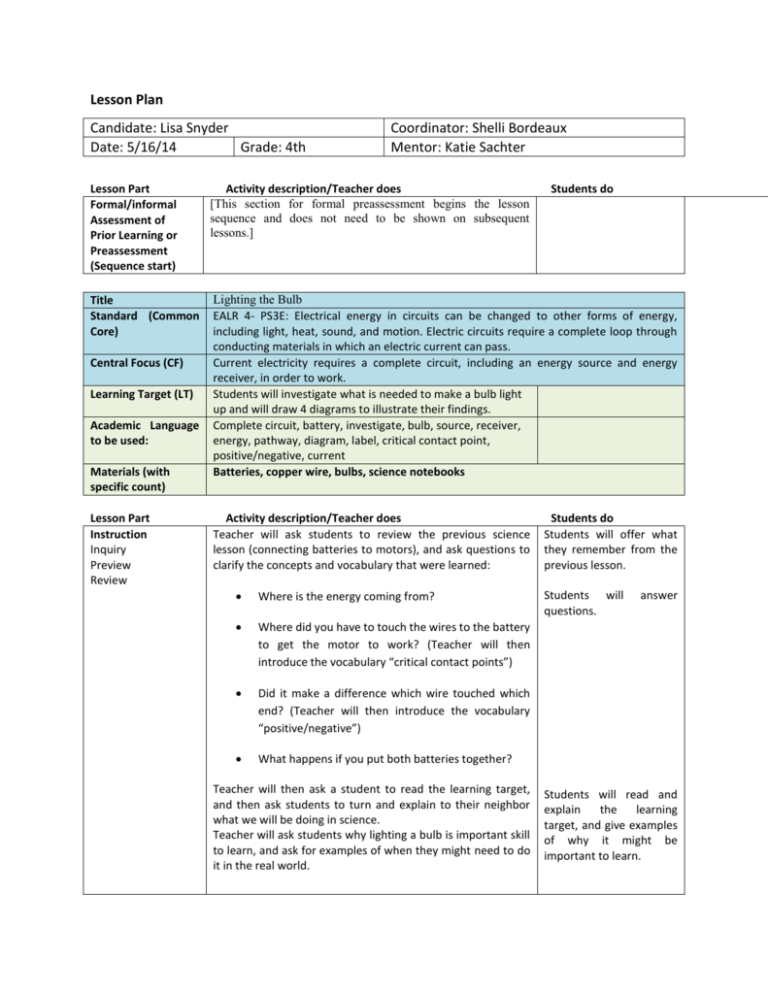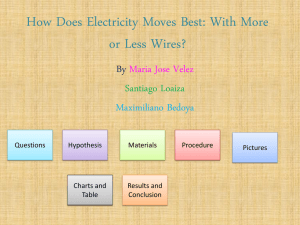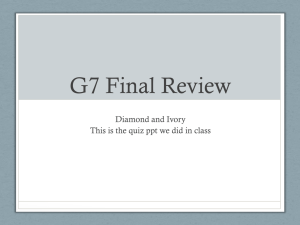Circuits Pathways Lesson 2
advertisement

Lesson Plan Candidate: Lisa Snyder Date: 5/16/14 Grade: 4th Coordinator: Shelli Bordeaux Mentor: Katie Sachter Lesson Part Formal/informal Assessment of Prior Learning or Preassessment (Sequence start) Activity description/Teacher does [This section for formal preassessment begins the lesson sequence and does not need to be shown on subsequent lessons.] Title Standard (Common Core) Lighting the Bulb EALR 4- PS3E: Electrical energy in circuits can be changed to other forms of energy, including light, heat, sound, and motion. Electric circuits require a complete loop through conducting materials in which an electric current can pass. Current electricity requires a complete circuit, including an energy source and energy receiver, in order to work. Students will investigate what is needed to make a bulb light up and will draw 4 diagrams to illustrate their findings. Complete circuit, battery, investigate, bulb, source, receiver, energy, pathway, diagram, label, critical contact point, positive/negative, current Batteries, copper wire, bulbs, science notebooks Central Focus (CF) Learning Target (LT) Academic Language to be used: Materials (with specific count) Lesson Part Instruction Inquiry Preview Review Activity description/Teacher does Teacher will ask students to review the previous science lesson (connecting batteries to motors), and ask questions to clarify the concepts and vocabulary that were learned: Where is the energy coming from? Where did you have to touch the wires to the battery to get the motor to work? (Teacher will then introduce the vocabulary “critical contact points”) Did it make a difference which wire touched which end? (Teacher will then introduce the vocabulary “positive/negative”) What happens if you put both batteries together? Teacher will then ask a student to read the learning target, and then ask students to turn and explain to their neighbor what we will be doing in science. Teacher will ask students why lighting a bulb is important skill to learn, and ask for examples of when they might need to do it in the real world. Students do Students do Students will offer what they remember from the previous lesson. Students will questions. answer Students will read and explain the learning target, and give examples of why it might be important to learn. Informal Assessment Instruction/Practice Activity/ (if needed) Informal Assessment Instruction/Practice/ Activity (if needed) Closure Assessment of Student Voice Gifted/early finishers Teacher will then explain that today we will be figuring out what is needed to make the light bulb light up. Teacher will model setting up the science notebook on the document camera, as students follow along. Teacher will then ask students to make a prediction as to what is needed to make a bulb light up. Teacher will explain the investigation: students will be using a light bulb, battery, and wire to try to find as many ways as they can to light up the bulb. Students must draw diagrams of each successful AND unsuccessful arrangement that they try. Teacher will display the science journal entry checklist on the document camera as students work. Teacher will circulate, asking students questions to assess their knowledge of circuits and their different parts: What are the critical contact points on the battery? The bulb? What have you tried so far? Why do you think that did/didn’t work? What could you try next? Where is the energy coming from? Where is it going to? Once most students have completed at least four diagrams, teacher will ask them to try to light the bulb using two wires. Students will work in pairs for this. They must complete at least one diagram using two wires. Teacher will bring the class back together and ask a student (choose somebody during previous activities) to come up to the board to draw one of their arrangements. Why does this arrangement work? What are the critical contact points? Teacher will ask a different student to draw one of their battery and motor arrangements from the previous lesson, next to the light bulb diagram. Ask students to look for similarities between the two. Elicit the following: Both have batteries , a source of energy Both have wires connecting both ends of the battery Both have an object that uses the electricity. Explain that in order for an electric current to flow, we must have a complete circuit: a continuous loop that connects the critical contact points of the battery. Draw arrows on the student diagrams to demonstrate the path of the electricity. Teacher will ask students to write a conclusion to their investigation by answering the focus question. Teacher will again display the notebook entry requirements on the document camera. Teacher will ask students to share some of the important things they learned today, and then review the lesson. Teacher will ask students to read the learning target and then assess how well they met it using a fist of five. Students who complete their circuits early will be asked to partner with another student and pool their materials. Challenge students to find ways to light the bulbs using all of the materials. Students will set up their notebooks following teacher directions. Students will predication. write a Students will carry out their investigation and record their findings. Students will attempt to light the bulb using two wires. A student will draw a diagram on the board. Students will explain why the arrangement works. A student will draw a battery and motor diagram on the board. Students will find similarities between the two circuits. Students will write their conclusions. Students will share what they learned and assess how well they met the learning target. ELL adaptations IEP/504 modifications Formal Assessment or Postassessment (Sequence end) ELL students will be given a graphic organizer for their diagrams in order to allow them to focus on the investigation rather than the production of a notebook entry. Students with IEP’s will be required to complete only two diagrams. Their notebook entries will be assessed using an adapted rubric. Students will be summatively assessed on their science notebook entries. Science Journal Entry Requirements 5/16/14: Lighting a Bulb Focus Question: What is needed to make a bulb light up? 1) Write the date, title, and focus question on the next blank page. 2) Write your prediction of the answer to the focus question. 3) Draw diagrams of all of your battery and bulb arrangements: both successful and unsuccessful. You need to have at least four diagrams. 4) All diagrams must include: Wires Battery Light bulb Critical contact points Labels 5) A conclusion that answers the focus question. Your conclusion must include: An explanation of the parts needed to light a bulb. An explanation of how the parts need to be arranged. Use of the vocabulary “Complete circuit” and “critical contact point”.








